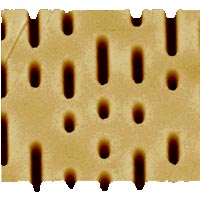
A scanning electron microscope image of a compact disk
showing rows of pits.

A scanning electron microscope image of a compact disk
showing rows of pits.
Introduction
You can find the spacing of lines in a compact disk by reflecting and diffracting a laser from the disk.
Material
To Do and Notice
Use the binder clips to mount the laser and the compact disk as shown.
Photo to come
The laser should reflect nearly straight back off one side of the vertically mounted compact disk to strike a distant white screen at least a meter away. (If the face of the compact disk were a clock reflect the laser from the 3 o'clock position.)
Measure the distance from the compact disk to the screen in meters, D.
Notice that there is a central dot of a reflected laser with two short arcs to either side.
Measure the distance between one of the arcs and the center beam, s, also in meters.
Compute the angle in radians between the central beam and the arcs. T = s/D
Calculate the distance between the lines on the compact disk in meters, d.
Use the equation derived in the Math Root on Interference.
d = L/T
where L is the wavelength of the light in meters. Red pointer lasers often have a wavelength near 730 nm = 7.3 x 10-7 m.
What's Going On?
The lines of pits that record the music in digital format on the CD are arranged in a spiral on the CD.
These lines act as a diffraction grating, reflecting the laser beam directly according to the usual law of reflection, this is called the zero order diffraction reflection.
The light is also reflected and diffracted at an angle T to the side of this zeroth order beam.
The angle T depends on the wavelength of the light and on the spacing of the lines.
The closer the lines the larger the angle, T.
The compact disk manufacturers standards specify the distance betwen the tracks to be 1.6 micrometers, 1.6 x 10^-6 m.
The transition from a pit to the "land" between the pits or a transition from the land to a pit represents a "1" in the digital recording on a compact disk. The lack of a transition specifies a "0".
Going Further
Do the same experiment with a DVD.
Notice immediately that the laser beam is deflected at a larger angle by the DVD thus the lines of pits on the DVD are closer together than those on a CD. This is one of the reasons that DVD's can store more information than CD's.
The manufacturer's standard specifies that the tracks on a DVD will be separated by 0.74 micrometers, 7.4 x 10^-7 M.
|
Scientific Explorations with Paul Doherty |
|
20 October 2000 |